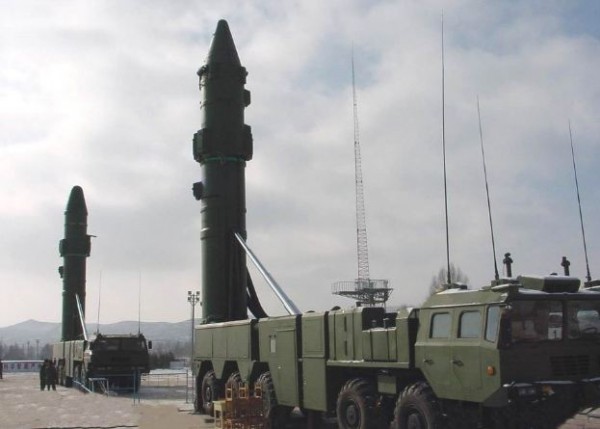China’s ‘Paper Dragon’ DF-21D ‘Carrier Killer’ Hasn’t Sunk a Single Ship at Sea
| Arthur Dominic Villasanta | | Jun 20, 2016 06:09 AM EDT |
Alleged carrier killers
The hype surrounding China's heavily hyped DF-21D anti-ship ballistic missile (ASBM) -- touted in Beijing propaganda as the "U.S. Carrier Killer" -- remains an example of clever advertising since this missile hasn't been tested over water and has never hit a ship at sea, even in a test.
Like Us on Facebook
It's been six years since the DF-21D burst into the world's consciousness as the linchpin of China's anti-access/anti-denial (A2/AD) strategy that aims to muscle the U.S. Navy out of the East China Sea and the South China Sea, which Beijing claims to own almost in its entirety. In that time, the claimed capabilities of this ASBM have never been proven by Beijing. In other words, the DF-21D is more bark than bite.
The Pentagon doesn't share the view in the popular media the missile is a "game changer" that's made all U.S. Navy aircraft carriers sitting ducks. For one, the DF-21D's warhead appears to be a copy of the 640 kg warhead of the obsolete American Pershing II missile withdrawn from service in 1988. And the Americans know a hit from only one Pershing-type warhead will damage a carrier, not sink it.
China's state-run media admits it will take up to three salvoes of DF-21Ds involving up to 10 missiles -- and not only one DF-21D -- to sink a U.S. carrier. The first salvo will destroy the carrier's flight deck and pierce its hull. The second will knock-out the engines while the third will sink the carrier.
Another propaganda video on YouTube shows warheads from a DF-21D destroying an entire U.S. Navy carrier battle group in a nuclear explosion. Current DF-21Ds aren't armed with nuclear weapons and to do so would invite instant nuclear retaliation from the United States.
China, however, claims it successfully used the DF-21D to "sink" a "U.S. carrier" but this was a carrier painted on the sands of the Gobi Desert in northern China. Satellite images from Google Earth reveal a 200 meter-long white-painted platform simulating the flight deck of a U.S. aircraft carrier. China claims to have "sunk" this U.S. carrier with the two "hits" shown in the Google photos.
One Western expert noted the absence of over water testing will validate the military maxim technology not perfected in peacetime will tend to disappoint in wartime. Beijing, however, has good reasons for not testing the DF-21D or a newer upgrade, the DF-26, by launching it over the East China Sea, the South China Sea or the Pacific Ocean.
These tests would instantly be detected by U.S. satellites comprising the Space-Based Infrared System (SBIRS) designed to provide early missile warning and missile defense data. Tracking the ballistic path of the DF-21D will give the U.S. more data that might confirm or deny the propaganda specs Beijing claims for its alleged carrier killer.
China claims the land-launched DF-21D can achieve high-hypersonic speeds in excess of Mach 10 (12,000 km/h). Some U.S. analysts, however, believe the DF-21D can't fly faster than Mach 5 (6,000 km/h), which is about as fast as the newest version of India's BrahMos anti-ship missile, currently the fastest of its type in the world.
Of more importance, over water tests will allow the U.S. to detect and verify the "kill chain" that guides the DF-21D to its over-the-horizon targets. The DF-21D has radar and optical sensors that track distant targets but these haven't yet been tested against a warship wildly maneuvering at up to 30 knots (55 km/h) while being subjected to intense electronic warfare countermeasures and jamming.
A Russian military analysis revealed the only way to successfully counter the DF-21D is by using electronic countermeasures, and the U.S. Navy is equipped to do this.
The U.S. Navy has long known the greatest weakness of an ASBM is its kill chain and disrupting any of that chain's essential elements will transform an ASBM into a useless chunk of metal plunging earthwards.
Analysts concur that for China to successfully attack a U.S. Navy ship with the DF-21D, it must first detect the ship and identify it as a U.S. warship of a type it wants to attack (such as an aircraft carrier).
The rocket forces of the People's Liberation Army from a land base in mainland China must then precisely determine the target's location using up-to-the-minute data so a DF-21D can be launched against it.
Chinese controllers must also provide mid-course updates to the ASBM using its incomplete BeiDou GPS satellite system or long-range aerial drones still in development. Finally, the warhead must lock onto and home in on the maneuvering U.S. Navy warship that's launching surface-to-air missiles against it.
BeiDou will only have its complete complement of 35 GPS satellites by 2020. China orbited its 23rd BeiDou satellite only this month.
China is, therefore, currently incapable of successfully accomplishing this entire kill chain, rendering the DF-21D a paper dragon fearful only in appearance.
TagsDF-21D, anti-ship ballistic missile, china, U.S. Navy, aircraft carriers aircraft carriers
©2015 Chinatopix All rights reserved. Do not reproduce without permission
EDITOR'S PICKS
-

Did the Trump administration just announce plans for a trade war with ‘hostile’ China and Russia?
-

US Senate passes Taiwan travel bill slammed by China
-

As Yan Sihong’s family grieves, here are other Chinese students who went missing abroad. Some have never been found
-

Beijing blasts Western critics who ‘smear China’ with the term sharp power
-

China Envoy Seeks to Defuse Tensions With U.S. as a Trade War Brews
-

Singapore's Deputy PM Provides Bitcoin Vote of Confidence Amid China's Blanket Bans
-

China warns investors over risks in overseas virtual currency trading
-

Chinese government most trustworthy: survey
-

Kashima Antlers On Course For Back-To-Back Titles
MOST POPULAR
LATEST NEWS
Zhou Yongkang: China's Former Security Chief Sentenced to Life in Prison

China's former Chief of the Ministry of Public Security, Zhou Yongkang, has been given a life sentence after he was found guilty of abusing his office, bribery and deliberately ... Full Article
TRENDING STORY

China Pork Prices Expected to Stabilize As The Supplies Recover

Elephone P9000 Smartphone is now on Sale on Amazon India

There's a Big Chance Cliffhangers Won't Still Be Resolved When Grey's Anatomy Season 13 Returns

Supreme Court Ruled on Samsung vs Apple Dispute for Patent Infringement

Microsoft Surface Pro 5 Rumors and Release Date: What is the Latest?












